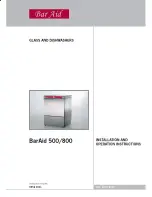
Troubleshooting
en-us
41
Dishwasher
seems to run a
long time
Incoming water is not warm
enough.
Before starting a cycle, run hot water faucet
at the sink closest to the dishwasher.
Cycle time can vary due to soil and
water conditions.
Sensors in the dishwasher automatically
increase the cycle time to ensure a good
wash when heavy soil is detected.
Rinse aid dispenser
9*
is empty,
or rinse aid setting has been set to
“0”.
Add rinse aid, or change rinse aid setting.
Dishwasher connected to cold
water supply.
Note:
Check the typical wash cycle
length.
Verify dishwasher is connected to hot water
supply plumbing.
Dishes are not
getting clean
enough
Spray arm movement obstructed.
Ensure that spray arm movement is not
blocked by hand rotating spray
arms
1:
,
1R
before starting cycle.
Spray arm nozzles clogged.
Remove spray arms
1:
,
1R
and clean
them.
Improper use of detergents.
Increase or decrease detergent depending
on the water hardness.
Filters
1b
could be clogged.
Clean the filters
1b
Dishes are nested or loaded too
closely together.
Rearrange load such that water spray can
reach all items in the dishwasher.
"Loading the Dishwasher" on page 15
Selected wash cycle is not suitable
for food soil conditions.
Refer to Wash Cycle Information.
"Wash Cycle Information" on page 29
Streaks on
glassware or
residue on the
dishes
Incorrect rinse aid setting.
Depending on the hardness of water, adjust
the rinse agent dispenser
9*
.
Dishes are not
getting dry
enough
Note:
Plastic or
Teflon do not
typically dry as
well as other
items due to
their inherent
properties.
Rinse aid dispenser
9*
is empty
or incorrect rinse aid amount is set.
Add rinse aid or adjust setting - the use of
rinse agent improves drying, use the Auto
cycle, use the Sanitize option.
Improper loading of dishes.
Rearrange load to ensure items are not
Note:
Select models offer an extra heating
option to improve drying performance.
















































